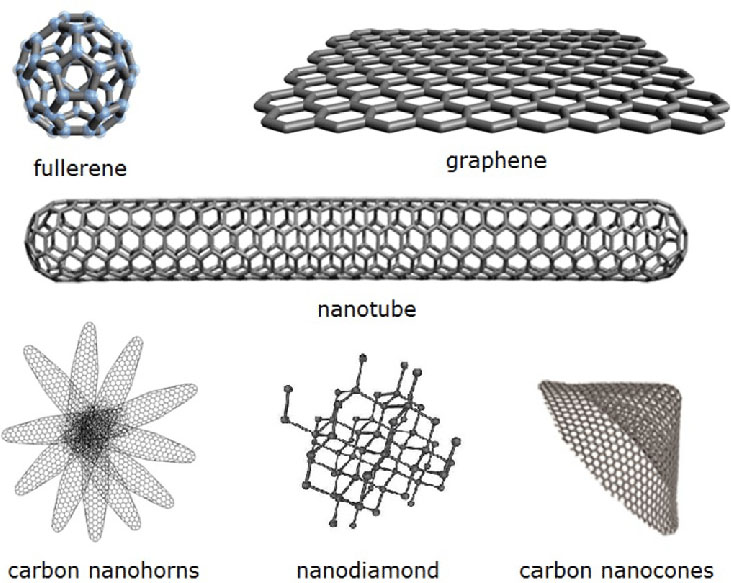Carbon Nanomaterials: Versatile Building Blocks for Nanotechnology
What are Carbon Nanomaterials?
Carbon nanomaterials are a class of nanoscale materials composed primarily of carbon atoms. These materials are different allotropes of carbon, meaning they have distinct physical structures but are composed of the same element. The most well-known carbon nanomaterials include carbon nanotubes, graphene, fullerenes, and carbon dots. Each of these allotropes exhibits unique physical, chemical, and electrical properties that make them highly attractive for a wide range of applications in nanotechnology.

Types of Carbon Nanomaterials
Carbon nanomaterials can be classified into several categories based on their structure and dimensionality:
Carbon Nanotubes (CNTs)
Carbon nanotubes are cylindrical structures made of rolled-up graphene sheets. They can be single-walled (SWCNTs), with a diameter of around 1 nm, or multi-walled (MWCNTs), with diameters ranging from a few to several hundred nanometers. CNTs exhibit exceptional mechanical strength, high electrical and thermal conductivity, and unique optical properties.
Graphene
Graphene is a two-dimensional material consisting of a single layer of carbon atoms arranged in a hexagonal lattice. It is the thinnest known material and possesses extraordinary properties, such as high electron mobility, excellent thermal conductivity, and superior mechanical strength. Graphene has the potential to revolutionize various fields, including electronics, energy storage, and composite materials.
Fullerenes
Fullerenes are spherical or ellipsoidal molecules composed entirely of carbon atoms. The most well-known fullerene is C60, also known as buckminsterfullerene, which consists of 60 carbon atoms arranged in a soccer ball-like structure. Fullerenes have unique electronic and optical properties and find applications in solar cells, drug delivery, and biomedical imaging.
Carbon Dots
Carbon dots are small, quasi-spherical nanoparticles with diameters typically below 10 nm. They are composed of sp2-hybridized carbon atoms and exhibit excellent photoluminescence properties, making them promising candidates for bioimaging, sensing, and optoelectronic applications.
Synthesis Methods
Various synthesis methods have been developed to produce carbon nanomaterials with controlled properties and morphologies. Some common synthesis techniques include:
Chemical Vapor Deposition (CVD)
Chemical Vapor Deposition is a widely used method for synthesizing carbon nanotubes and graphene. In this process, a carbon-containing precursor gas, such as methane or ethylene, is decomposed at high temperatures in the presence of a catalyst, leading to the growth of carbon nanomaterials on a substrate.
Arc Discharge
Arc discharge is a high-temperature method used to produce carbon nanotubes and fullerenes. In this technique, a high current is passed between two graphite electrodes in an inert atmosphere, causing the vaporization of carbon atoms and their subsequent condensation into nanostructures.
Laser Ablation
Laser ablation involves the use of a high-power laser to vaporize a graphite target in an inert atmosphere. The vaporized carbon atoms condense and form carbon nanotubes or other nanostructures, which are collected on a cold substrate.
Hydrothermal and Solvothermal Synthesis
Hydrothermal and solvothermal methods involve the heating of carbon precursors in a sealed reactor containing water or organic solvents at high temperatures and pressures. These methods are particularly useful for synthesizing carbon dots and other small carbon nanoparticles.
Properties and Applications
Carbon nanomaterials exhibit a wide range of exceptional properties that make them highly attractive for various applications in nanotechnology:
Mechanical Properties
Carbon nanotubes and graphene possess extraordinary mechanical strength and stiffness. They are among the strongest known materials, with tensile strengths up to 100 times higher than steel. These properties make them ideal for reinforcing composite materials, creating ultra-strong fibers, and developing high-performance mechanical devices.
Electrical Properties
Carbon nanomaterials, particularly carbon nanotubes and graphene, exhibit excellent electrical conductivity. They can carry high current densities and have high electron mobility, making them promising for applications in nanoelectronics, sensors, and energy storage devices, such as supercapacitors and batteries.
Thermal Properties
Carbon nanomaterials have high thermal conductivity, which makes them attractive for heat management applications. They can be used in thermal interface materials, heat sinks, and thermal management systems for electronic devices.
Optical Properties
Some carbon nanomaterials, such as carbon dots and certain types of carbon nanotubes, exhibit unique optical properties, including photoluminescence and strong light absorption. These properties find applications in bioimaging, sensing, solar cells, and optoelectronic devices.
Biomedical Applications
Carbon nanomaterials have shown great potential in biomedical applications due to their biocompatibility, high surface area, and unique properties. They can be used in drug delivery systems, biosensors, tissue engineering scaffolds, and medical imaging agents.
Challenges and Future Perspectives
Despite the tremendous progress in the field of carbon nanomaterials, several challenges remain to be addressed. One of the main challenges is the large-scale production of high-quality carbon nanomaterials with consistent properties. The development of cost-effective and scalable synthesis methods is crucial for the widespread adoption of these materials in various applications.
Another challenge is the potential health and environmental risks associated with carbon nanomaterials. As these materials become more widely used, it is essential to thoroughly investigate their toxicity and develop appropriate safety guidelines for their handling and disposal.
Future research in carbon nanomaterials will focus on the development of novel synthesis methods, the exploration of new carbon nanostructures, and the integration of carbon nanomaterials with other nanomaterials to create multifunctional hybrid systems. Additionally, the application of carbon nanomaterials in emerging fields, such as flexible electronics, wearable devices, and energy harvesting, will continue to drive research and innovation in this exciting area of nanotechnology.
Further Reading
Materials Science and Engineering: B, Carbon nanomaterials: Synthesis, properties and applications in electrochemical sensors and energy conversion systems
